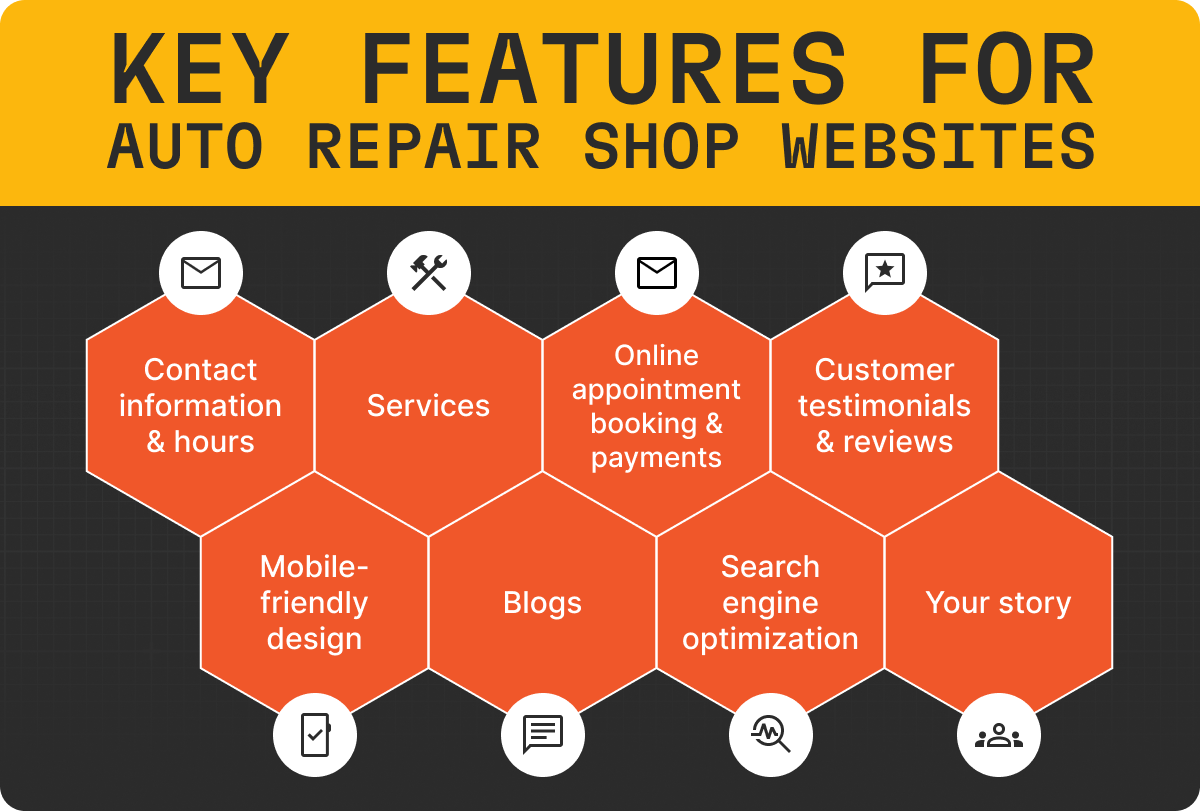In today's digital world, relying solely on word-of-mouth is like trying to change a tire with a pair of pliers—it’s inefficient and frustrating. You need a modern tool, a solution designed to attract new customers to your shop. That tool is Google Ads, a Pay-Per-Click (PPC) advertising platform allowing you to target new customers when they need you most.
If you've heard the term but aren't sure how it fits into your business plan, you're in the right place. This comprehensive guide will break down everything you need to know about Google Ads for your auto repair business.
What are Google Ads (PPC)?
At its core, Google Ads is a Pay-Per-Click, or PPC, platform where advertisers pay a fee each time one of their ads is clicked. Think of it as renting a prime piece of real estate on the first page of a search engine like Google or Bing. Instead of trying to earn those top spots organically through Search Engine Optimization (SEO), which can take months or even years, you're essentially paying to jump the line.
Types of Google Ad Campaigns
Search campaigns
Paid search ads are the most common type of Google Ad campaign, allowing auto repair shops to target based on keywords. Shops can find new customers by bidding on keywords like “Oil change near me” or “Transmission shop Denver, Colorado.” This campaign type is effective because you can target local customers at the moment they are searching for help.
Display campaigns
Display PPC campaigns are another effective campaign type that shops can use to target customers with more creative ads. Display ads offer a visual component that could be a static image or a short video. Display ads can show across a wider audience and are not confined to just Google search.
Retargeting campaigns
Retargeting campaigns are exactly what they sound like. Mechanic shops can target prospects who have visited their website with ads that can display on other websites. For example, a customer could have visited your website (YourShop.com) and then bounced to Forbes.com. You can then show an ad on Forbes.com (and other websites) as they browse the web, so your shop can stay top of mind.
Video campaigns
Video campaigns are mainly used by auto repair shops to target customers on YouTube. You can target automotive DIY videos where users may run into issues and look for a shop instead.
How to set up your first Google Ad campaign
- Open a Google Ads account (if you haven’t already). Fill out your business information and attach your payment method. This is also a good time to delegate account access to other employees if needed.
- Start your keyword research. Identify the search terms your potential customers are typing into Google when they need help (e.g., “brake repair near me,” “check engine light diagnostics,” “mechanic in Houston”). If you need help finding the right keywords, you can start by asking the next customer who walks in your door, “How did you hear about us?”.
- Finalize your budget and bidding. Set the maximum amount you're willing to pay for a single click on your ad. This bid, combined with the quality and relevance of your ad, determines your ad's ranking position.
- Find your audience. Select which geographical areas you want to target with your ads. Most shops select a radius around their physical location to ensure they are targeting customers nearby.
- Add extensions. Extensions show up beneath your ad and can include your phone number or service-specific pages of your website. Extensions help you take up more room on Google and increase your chances of attracting a click.
- Publish. Once you publish your ads, your ads will go through an approval process and either go live or be rejected. You can always make edits and resubmit your ads if they are initially rejected.
- Monitor and analyze. Once your ads are running, you will be able to see clicks, impressions, cost, and other data in the Google Ads platform. You can even set up conversions and UTM tracking to see how many new customers are scheduling online appointments with your shop.
Should Mechanic shops use Google Ads?
The short answer is an emphatic yes. While many forms of marketing cast a wide net, hoping to catch a few fish, PPC marketing is like using a high-tech fish finder. For an auto repair shop, the "when" is just as important as the "who," and Google Ads excel at connecting you with customers at the moment of their highest intent.
Consider the mindset of a person who needs auto repair services. Their car is making a strange noise, a warning light is on, or worse, they're stranded on the side of the road. They aren't casually browsing; they have an urgent, specific problem that needs an immediate solution. What do they do? They pull out their phone and perform a Google search for a local mechanic.
This is where auto repair PPC shines. It allows your auto repair shop to appear at the very top of the results for those high-intent searches. You're not interrupting their day with an ad they don't care about; you are providing the exact solution they are actively looking for. This makes Google Ads one of the most effective marketing efforts for service businesses, especially in the emergency-driven auto repair industry. It levels the playing field, allowing dedicated local shops to gain immediate online visibility and compete effectively against large national chains.
Benefits of PPC Marketing for Auto Repair Shops
Integrating a well-managed PPC advertising campaign into your marketing strategy can deliver a host of powerful benefits that translate directly into more customers and higher revenue.
- Immediate Traffic: Unlike email marketing or social media, a PPC campaign can start to drive traffic and generate phone calls almost overnight. Once your ad campaigns are approved, your shop can be visible to potential customers within hours, which is crucial when you have empty bays to fill.
- Precise Targeting: PPC platforms offer incredibly granular targeting options. You can show your ads to people based on:
- Location: Target users within a specific mile radius of your shop, in certain zip codes, or in an entire city. This ensures you’re not paying for clicks from people who are too far away to become customers.
- Keywords: You target the exact automotive services you offer, from a simple oil change to complex engine issues.
- Time of Day: Only want to run ads during your business hours to ensure someone is there to answer the phone? You can do that.
- Device: You can bid more for mobile users, who are more likely to be in need of immediate help and use click-to-call features.
- Budgetary Control: Worried about a runaway budget? With PPC, you're in the driver's seat. You set a maximum daily or monthly ad spend, and you'll never pay more than that amount. You can start small, test the waters, and scale your investment up or down based on your return on investment.
- Measurable Results: This is a major advantage over traditional advertising. Every aspect of your PPC campaigns can be tracked. You can see exactly how many people saw your ad, how many clicked it, and how many of those clicks resulted in a phone call or a contact form submission.
- Increased Brand Awareness: Even when users don't click on your ad, seeing your shop's name at the top of the search results builds familiarity and trust. When they see your name repeatedly for different service-related searches, you become a recognized authority in your local area. This boost in brand awareness is a valuable byproduct of a consistent PPC presence.

Effective PPC Strategies for Auto Repair Shops
Launching a campaign is easy; launching a profitable one requires a solid strategy. Simply throwing money at Google Ads without a plan is a quick way to burn through your budget. Here are the essential strategies to ensure your PPC ads deliver results.
Keyword Research
This is the foundation of your entire campaign. You need to get inside the heads of your target audience and think of keywords they would search for. Your keyword research should include:
- Service-Specific Keywords: "brake pad replacement," "transmission repair," "car AC service."
- Location-Based Keywords: "auto mechanic Dallas," "car repair shop 75201."
- "Near Me" Keywords: These are huge for local service businesses. Google often appends "near me" automatically for mobile searchers.
- Negative Keywords: Just as important is telling Google what not to show your ads for. Add negative keywords like "jobs," "training," "DIY," "parts," and "free" to avoid paying for irrelevant clicks from job seekers or people looking to do the work themselves.
You should note that each keyword has a different cost per click average depending on location and number of competitors. Bid on keywords that are important for your shop and fit your budget.
Compelling Ad Copy
Your ad copy is your 3-second elevator pitch. It needs to grab attention and persuade the user to click.
- Highlight Your Strengths: What makes you different? Mention your ASE-certified technicians, warranties on parts and labor, free loaner cars, 5-star reviews, or your years of experience.
- Include a Strong Call-to-Action (CTA): Be direct. Use phrases like "Call Now for a Free Estimate," "Book Your Service Online," or "Get a Quick Quote."
- Use Ad Extensions: These are extra snippets of information that make your ad bigger and more useful. Use call extensions to add your phone number for easy click-to-call, and location extensions to show your address and link to Google Maps. Sitelink extensions can direct users to specific service pages on your website.
Optimized Landing Pages
A click is wasted if the user gets to your website and is confused or unimpressed. Your landing pages must be designed to convert visitors into customers.
- Relevance is Key: If your ad promises "Brake Repair Services," the landing page should be all about your brake repair services, not your homepage.
- Mobile-First Design: The majority of auto repair searches happen on mobile phones. Your page must load fast and be easy to navigate on a small screen.
- Clear Contact Information: Your phone number and address should be prominently displayed and clickable.
- Build Trust: Feature customer reviews, testimonials, photos of your shop, and logos of any certifications (ASE, AAA Approved, etc.).
Bidding and Campaign Management
Google Ads is not a "set it and forget it" strategy. To truly succeed, you need to actively manage and optimize your campaigns.
- Structure Your Campaigns: Create separate PPC campaigns for each major service category (e.g., Brakes, Engine, Transmission, General Maintenance). This allows you to tailor your ads and landing pages for maximum relevance, which Google rewards with a better Quality Score and lower CPC.
- Track Everything: Implement conversion tracking to monitor not just clicks, but actual leads—phone calls and form submissions. This is the only way to measure true campaign performance.
- Continuously Optimize: Regularly review your metrics. Pause keywords that aren't performing, test new ad copy, and adjust bids to focus your ad spend on what drives the best conversion rates.
How Much Should Automotive Shops Invest in Google Ads?
This is the most common question, and the answer is: it depends. The right budget for your shop is influenced by several factors, including your location's competitiveness, the specific services you're advertising, and your overall growth goals. A shop in rural Nebraska will have a much lower cost per click than one in downtown Los Angeles.
Instead of focusing on a magic number, think about your investment in terms of objectives and ROI. A good starting point for a small to medium-sized auto repair shop might be anywhere from $500 to $2,000 per month. This initial investment allows you to gather enough data to see what works.
The most important metric isn't the upfront price; it's the return on investment. If you spend $1,000 on Google Ads in a month and it brings in five new repair jobs that generate $4,000 in revenue, your marketing efforts have delivered a 4x return. From that perspective, the initial cost is more than justified.
For shops new to this space, partnering with a digital marketing agency that specializes in Google AdWords services can be a wise investment. They have the expertise to avoid common pitfalls, maximize your budget, and accelerate your path to profitability.
Final Thoughts
In a competitive market, standing still means falling behind. Pay-per-click advertising is the fuel your marketing strategy needs to accelerate past the competition. It offers an unparalleled ability to connect with customers at their moment of need, providing immediate, targeted, and measurable results.
By conducting thorough keyword research, crafting compelling ads, building high-converting landing pages, and diligently tracking your campaign performance, you can transform your online presence from a sputtering engine into a finely tuned machine that consistently delivers new customers. It’s time to take control of your lead generation and explore what a well-executed auto repair PPC campaign can do for your shop.


.png)

.png)
.png)



.svg)



.svg)